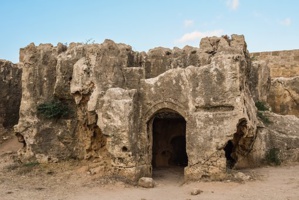Archaeologists dug out a city in Pompeii which was buried beneath a volcanic eruption which took place in “79 AD”. The interest and “extraordinary” discovery from this site is of a “frescoed hot food and drinks shop” which used to serve the Roman passerby something equivalent to our modern street food.
In Latin, the counters for hot drinks are called as “termopolium” while the find is located in the “archaeological park’s Regio V site” wherein public entry is still restricted. In fact, the archaeologists even found traces of food that are “nearly 2,000-year-old” within some “terra cotta jars” which were used to store hot food, while the shop keeper lowered them into “a counter with circular holes”.
The counter front sported “bright coloured frescoes” with animal depictions which were probably used as ingredients in the foods that were being sold, for “a chicken and two ducks hanging upside down”. The Director of the “Pompeii archaeological park”, Massimo Ossana said:
“This is an extraordinary find. It’s the first time we are excavating an entire termopolium”.
Additionally, the archaeologists also discovered “a decorated bronze drinking bowl” which is called a “patera” along with ceramic jars used for “cooking stews and soups”, as well as “wine flasks and amphora”. Furthermore, Reuters added:
“Pompeii, 23 km (14 miles) southeast of Naples, was home to about 13,000 people when it was buried under ash, pumice pebbles and dust as it endured the force of an eruption equivalent to many atomic bombs”.
While, an anthropologist from the site, Valeria Amoretti said:
“Our preliminary analyses shows that the figures drawn on the front of the counter, represent, at least in part, the food and drink that were sold there”.
Revealing further about the food portions found within the containers, Amoretti enlists items such as “pork, fish, snails and beef”, whereby terming it to be a “testimony to the great variety of animal products used to prepare dishes”. The ancient tow unearthed so far covers around “66-hectare”. The ruins were discovered sometimes in the sixteenth century while the work of “organised excavations” started around 1750. The said site, added Reuters, is a “rare documentation of Greco-Roman life”, where “Pompeii is one of Italy’s most popular attractions and a UNESCO World Heritage Site”.
References:
reuters.com
In Latin, the counters for hot drinks are called as “termopolium” while the find is located in the “archaeological park’s Regio V site” wherein public entry is still restricted. In fact, the archaeologists even found traces of food that are “nearly 2,000-year-old” within some “terra cotta jars” which were used to store hot food, while the shop keeper lowered them into “a counter with circular holes”.
The counter front sported “bright coloured frescoes” with animal depictions which were probably used as ingredients in the foods that were being sold, for “a chicken and two ducks hanging upside down”. The Director of the “Pompeii archaeological park”, Massimo Ossana said:
“This is an extraordinary find. It’s the first time we are excavating an entire termopolium”.
Additionally, the archaeologists also discovered “a decorated bronze drinking bowl” which is called a “patera” along with ceramic jars used for “cooking stews and soups”, as well as “wine flasks and amphora”. Furthermore, Reuters added:
“Pompeii, 23 km (14 miles) southeast of Naples, was home to about 13,000 people when it was buried under ash, pumice pebbles and dust as it endured the force of an eruption equivalent to many atomic bombs”.
While, an anthropologist from the site, Valeria Amoretti said:
“Our preliminary analyses shows that the figures drawn on the front of the counter, represent, at least in part, the food and drink that were sold there”.
Revealing further about the food portions found within the containers, Amoretti enlists items such as “pork, fish, snails and beef”, whereby terming it to be a “testimony to the great variety of animal products used to prepare dishes”. The ancient tow unearthed so far covers around “66-hectare”. The ruins were discovered sometimes in the sixteenth century while the work of “organised excavations” started around 1750. The said site, added Reuters, is a “rare documentation of Greco-Roman life”, where “Pompeii is one of Italy’s most popular attractions and a UNESCO World Heritage Site”.
References:
reuters.com






